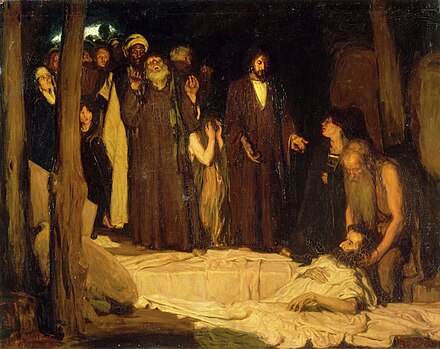| The Resurrection of Lazarus | |
|---|---|
| French: La Résurrection de Lazare | |
 | |
| Artist | Henry Ossawa Tanner |
| Year | 1896 |
| Medium | Oil on canvas |
| Dimensions | 90.7 cm × 120.5 cm (35.7 in × 47.4 in) |
| Location | Musée d'Orsay, Paris |
The Resurrection of Lazarus is a painting by Henry Ossawa Tanner entered into the Paris Salon in 1897 and winning a third place medal.[1][2] During his lifetime, this was the painting for which he was most known, his "masterwork".[2] Since his death in 1937, secular tastes have pushed The Banjo Lesson to the top place in public esteem.[2] The work was purchased by the French government (a rare honor for someone not a French citizen) for display in its Luxemburg museum.[2] Today the painting is held by the Musée d'Orsay.[2]
During Tanner's lifetime, the painting was never exhibited in the United States, having been bought at its first exhibition in France.[2] It was finally exhibited in the U.S. in 2012 as part of the show Henry Ossawa Tanner: Modern Spirit, organized by the Pennsylvania Academy of Fine Arts.[3]
- ^ "An American Colored Artist Wins the Medal of Honor. Letter in New York Post". The Indianapolis Journal. Indianapolis, Indiana. 13 June 1897. p. 12.
At the opening of the Salon of the Champs Elysees—the only salon conferring official honors—a painting by a new American artist was favorably noticed. Afterwards it was numbered among the annual acquisitions of the French state. Finally, it has carried off a third medal, a distinction which it shares this year with the work of only one other American painter...The subject of his painting is Resurrection of Lazarus. It is a small canvas, with Christ standing at the head of the open tomb from which Lazarus is lifted up. Behind are the Jews in attitudes of wonder. The light on all these figures is from the reddish blaze of lanterns. In the background is a bit of blue sky, seen through the entrance to the sepulchre. It is not a great painting, nor even faultless in drawing and color. But it is a meritorious precisely for those qualities of permanent value, which all masters have aimed at, but which are ignored by many of the younger artists. Its composition is original, without upsetting what may be called the ideas of the scene, and its color scheme is not one which might be admissible in an impressionist landscape.
- ^ a b c d e f Simpson, Marc (2012). "3 The Resurrection of Lazarus from the Quartier Latin to the Musée du Luxembourg". In Marley, Anna O. (ed.). Henry Ossawa Tanner: Modern Spirit. Berkeley: University of California Press. pp. 28, 69–75.
- ^ Marley, Anna O., ed. (2012). Henry Ossawa Tanner: Modern Spirit. Berkeley: University of California Press. pp. 195, title page.